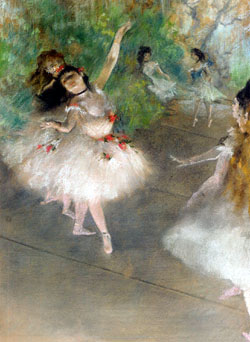
Alright, so it was a tie between Cassat and Degas, and eventually I decided on Degas. Edgar Degas was an impressionist painter who was born in Paris, France on July 19th, 1834. By his early life, he had begun painting seriously, though under his father's wishes he attended law school. Without much motivation at law school, he eagerly accepted admission into Ecole des Beaux-Arts and flourished while studying drawing with Louis Lamothe. He traveled to Italy in July 1856 for three years, drawing and painting copies of Michaelangelo, Raphael, Titian, and other artists if the Renissance, usually selecting an individual head for a portrait. During this time, he studied and became accomplished with techiniques involving high, academic, and classical art.
Upon return to France in 1859, he began copying paintings at the Louvre, and presented exhibits anually in the Salon for the next five years. His art began to incline more towards contemporary subject matter, which was especially influenced by Edouard Manet, whom he had met in the Louvre. In 1870, he joined the National Guard during the time of the Franco-Prussian War. After the war in 1872, he began an extended stay in New Orleans, Louisiana and produced more art, many of them consisting of family members and daily life for subject matter. When he returned to Paris in 1873 and became dependant on his artwork for income, he joined a new independent group of artists whom had been labeled the Impressionists. However, he had little in common with the others-not being a landscape painter and not painting outside, for instance-and eventually contributed to the break-up of the group.
Taking up photography and pastel, he is well-known for his works involving dancers and nudes. During his last years of life, which were sad and lonley, he was forced to stop his art due to near-blindness. He outlived many of his friends at an age of 83, eventually dying on September 27th, 1917.



